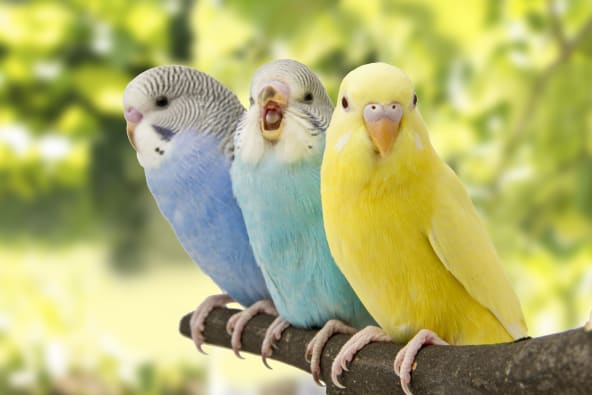Key Takeaways
-
Budgies are small, friendly birds that can be very affectionate and easy to train.
-
They are one of the most affordable pet birds, with low initial and ongoing costs.
-
Budgies are relatively quiet compared to other parrots, making them suitable for apartments.
-
They thrive in pairs, providing each other with social interaction and mental stimulation.
-
Budgies can mimic human speech, though their talking ability varies among individuals.
What Are the Pros and Cons of Having a Budgie as a Rescue Pet
Budgies, also known as budgerigars, are among the most popular pet birds worldwide. Their small size, vibrant colors, and playful nature make them appealing to many potential pet owners. However, like any pet, they come with their own set of pros and cons that you should consider before bringing one into your home.

“The 10 Best Types of Pet Birds | Tracy …” from www.tracyvets.com and used with no modifications.
Quick Overview of Budgies
Budgies are small parrots native to Australia. They are known for their bright plumage, which typically features shades of green, yellow, and blue. These birds are highly social and thrive on interaction, both with their human caretakers and other budgies. On average, budgies live between 5 to 10 years, though some can live longer with proper care.
Key Benefits of Owning a Budgie
One of the main benefits of owning a budgie is their affordability. Budgies are one of the least expensive pet birds you can buy. The initial cost of purchasing a budgie usually ranges from $10 to $35, depending on the color and age of the bird. Additionally, their ongoing care costs are relatively low compared to larger parrots.
Besides that, budgies are relatively quiet birds. While they do chirp and sing, their noise level is much lower than that of larger parrot species. This makes them an excellent choice for people living in apartments or other close-quarters housing. If you are interested in other birds, consider reading about the African Grey Parrot.
Another advantage is their small size. Budgies don’t require large cages, which means you can easily find a suitable spot for their habitat in your home. A cage that measures 18x18x24 inches is typically sufficient for a single budgie.
Budgies are also highly trainable. With patience and consistency, you can teach them to perform tricks and even mimic human speech. Their ability to learn and interact makes them engaging pets that can provide hours of entertainment.
Main Drawbacks to Consider
Despite their many benefits, budgies do have some drawbacks. One of the primary concerns is their fragility. Due to their small size, budgies can be easily injured if mishandled. Therefore, they may not be the best choice for very young children who might not understand how to handle them gently.
Additionally, budgies are highly social animals. While this can be a positive trait, it also means they require a lot of attention and interaction. If left alone for long periods, budgies can become lonely and stressed, leading to behavioral issues such as feather plucking or excessive chirping.
Another potential downside is their lifespan. While 5 to 10 years is a significant commitment, it is shorter compared to larger parrots, which can live for several decades. If you’re looking for a long-term pet, this might be a factor to consider.
Are Budgies the Same as Parakeets?
The terms “budgie” and “parakeet” are often used interchangeably, but there are some nuances to understand. All budgies are parakeets, but not all parakeets are budgies. Parakeet is a broad term that refers to a variety of small to medium-sized parrot species with long tail feathers. For example, another popular parrot species is the Amazon parrot, which is also part of the parakeet family.
Differences Between Budgies and Parakeets
The most common type of parakeet kept as a pet is the budgerigar, or budgie. However, other parakeet species include the Indian Ringneck Parakeet, the Monk Parakeet, and the Alexandrine Parakeet, among others. These species vary in size, color, and temperament.
-
Size: Budgies are smaller than most other parakeet species, typically measuring around 7 inches in length.
-
Color: While budgies are known for their bright green and yellow plumage, other parakeet species can come in a wide range of colors, including blue, red, and even multi-colored varieties.
-
Temperament: Budgies are generally more docile and easier to handle than some of the larger, more temperamental parakeet species.
Understanding these differences can help you make a more informed decision when choosing a pet bird. While budgies are a type of parakeet, they have unique characteristics that set them apart from other members of the parakeet family.
Talking Abilities of Budgies
One of the most fascinating aspects of budgies is their ability to mimic human speech. While not all budgies will talk, many can learn to say a few words or phrases. Male budgies are generally better at mimicking speech than females. Their smaller size and high-pitched voices make their speech less clear than larger parrots, but with patience, they can become quite chatty.
It’s important to note that individual budgies have different learning capabilities. Some may pick up words quickly, while others may never talk at all. However, even if your budgie doesn’t speak, they can still communicate in other ways, such as through chirps, whistles, and body language.
Tips for Teaching Budgies to Talk
Teaching a budgie to talk requires time, consistency, and a lot of patience. Here are some tips to help you get started:
-
Start Early: Younger budgies are more likely to learn to talk than older ones. Begin training as soon as your budgie is comfortable in its new home.
-
Repeat Words Clearly: Choose simple words or phrases and repeat them clearly and consistently. Words like “hello,” “good bird,” and the budgie’s name are good starting points.
-
Use Positive Reinforcement: Reward your budgie with treats or affection when they attempt to mimic your words. Positive reinforcement helps to encourage them to continue trying.
-
Be Patient: Learning to talk can take weeks or even months. Consistency is key, so practice daily and be patient with your budgie’s progress.
Do Budgies Need to Be in Pairs?
Budgies are highly social creatures that thrive on interaction. In the wild, they live in large flocks and form strong bonds with their flock mates. Therefore, many experts recommend keeping budgies in pairs to ensure they receive enough social interaction.
Benefits of Keeping Budgies in Pairs
There are several advantages to keeping budgies in pairs:
-
Companionship: Budgies provide each other with constant companionship, reducing feelings of loneliness and boredom.
-
Mental Stimulation: Interacting with another budgie helps keep their minds active and engaged, which can prevent behavioral issues.
-
Natural Behavior: Budgies in pairs can exhibit natural behaviors such as preening each other, playing, and communicating, which contributes to their overall well-being.
Challenges of Keeping Single Budgies
While it is possible to keep a single budgie, there are challenges to consider:
-
Increased Attention: A single budgie will rely on you for all its social interaction, which means you’ll need to spend more time with it to prevent loneliness.
-
Potential Behavioral Issues: Without a companion, a single budgie may develop behavioral problems such as feather plucking, excessive chirping, or aggression.
-
Higher Stress Levels: Budgies are naturally social, and being alone can cause stress and anxiety, impacting their health and happiness.
Why Are Budgies So Cheap?
One of the reasons budgies are popular pets is their affordability. But why are they so inexpensive compared to other pet birds? For more information on adopting pet birds, you might want to check out Amazon Parrot adoption.
Factors Contributing to Low Cost
Several factors contribute to the low cost of budgies:
-
High Breeding Rates: Budgies breed readily in captivity, resulting in a large supply of birds. This high availability helps keep prices low.
-
Low Maintenance: Budgies have relatively low maintenance costs compared to larger parrots. Their food, toys, and cage requirements are minimal, making them affordable to keep.
-
Small Size: Due to their small size, budgies require less food and smaller cages, which reduces the overall cost of ownership.
Cost Comparison with Other Birds
When comparing the cost of budgies to other pet birds, the difference is significant. For example, the cost of adopting an Abyssinian guinea pig can be much higher.
|
Bird Species |
Initial Cost |
Annual Maintenance Cost |
|---|---|---|
|
Budgie |
$10 – $35 |
$100 – $200 |
|
Cockatiel |
$75 – $150 |
$200 – $300 |
|
African Grey Parrot |
$500 – $1500 |
$500 – $1000 |
|
Macaw |
$1000 – $5000 |
$1000 – $2000 |
Final Thoughts on Adopting a Budgie
Budgies make wonderful pets for many reasons. They are affordable, relatively low-maintenance, and can provide endless entertainment with their playful personalities and ability to mimic speech. However, they do require social interaction and attention to thrive, so it’s important to consider your ability to meet their needs before adopting one. If you’re interested in other types of birds, you might want to learn about African Grey Parrot adoption as well.
Whether you choose to keep a single budgie or a pair, understanding their unique needs and behaviors will help ensure a happy and healthy life for your feathered friend. With proper care, budgies can become beloved members of your family, providing companionship and joy for years to come.
Summary of Key Points
To recap, here are the main points to consider when deciding if a budgie is the right pet for you: Budgies are social creatures and may benefit from having a companion. They are affordable and can be great pets for beginners. If you are interested in exploring other pet options, consider reading about Amazon parrot adoption.
-
Budgies are affordable and low-maintenance compared to other pet birds.
-
They thrive on social interaction and may benefit from being kept in pairs.
-
Budgies can mimic human speech, though their talking ability varies.
-
They are relatively quiet and suitable for apartment living.
-
Consider their social needs and potential behavioral issues before adopting a single budgie.
Recommendations for Potential Budgie Owners
If you’re considering adopting a budgie, here are some recommendations to help you get started:
It’s important to understand that budgies are better in pairs due to their social nature.
-
Do Your Research: Learn as much as you can about budgie care, behavior, and needs before bringing one home.
-
Set Up a Proper Habitat: Ensure you have a suitable cage, toys, and perches to keep your budgie entertained and comfortable.
-
Spend Time with Your Budgie: Interact with your budgie daily to build a strong bond and provide the social interaction they need.
-
Consider Getting a Pair: If possible, consider adopting two budgies to keep each other company and reduce loneliness.
-
Regular Vet Visits: Schedule regular check-ups with an avian vet to monitor your budgie’s health and catch any issues early.
Frequently Asked Questions (FAQ)
How long do budgies live?
Budgies typically live between 5 to 10 years, though with proper care, some can live up to 15 years or more. Factors such as diet, environment, and genetics play a significant role in their lifespan.
What do budgies eat?
Budgies require a balanced diet consisting of seeds, pellets, fresh fruits, and vegetables. A varied diet ensures they receive all the necessary nutrients for good health. Avoid feeding them avocado, chocolate, caffeine, and alcohol, as these can be toxic to birds.
How do I set up a habitat for my new rescue budgie?
Setting up a proper habitat for your budgie is crucial for their well-being. Here’s what you’ll need:
-
Cage: A cage measuring at least 18x18x24 inches for a single budgie. Ensure the bars are spaced no more than 1/2 inch apart to prevent escape.
-
Perches: Provide a variety of perches with different textures and diameters to keep their feet healthy.
-
Toys: Include toys for mental stimulation, such as swings, ladders, and chew toys. Rotate toys regularly to keep your budgie engaged.
-
Food and Water Dishes: Use sturdy dishes that can be securely attached to the cage. Clean them daily to prevent contamination.
-
Bird Bath: Budgies enjoy bathing, so provide a shallow dish of water for them to splash around in.
“A well-set-up habitat not only keeps your budgie healthy but also provides them with the mental stimulation they need to thrive.”
Remember, the key to a happy and healthy budgie is providing a stimulating environment, a balanced diet, and plenty of social interaction. With the right care and attention, your budgie can become a cherished companion for years to come.
Budgies are popular pets known for their vibrant colors and playful nature. Many people wonder if a budgie is the same thing as a parakeet. The answer is yes; budgies are a type of parakeet. These birds are also known for their ability to mimic human speech, making them entertaining companions. However, potential owners should consider whether budgies need to be in pairs to thrive. One reason why budgies are so cheap is their high availability in pet stores. If you’re interested in learning more about the pros and cons of owning a parakeet, this article provides detailed insights.


